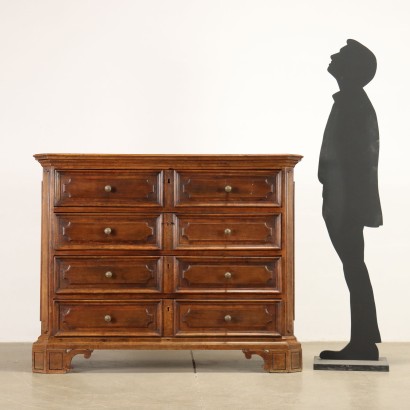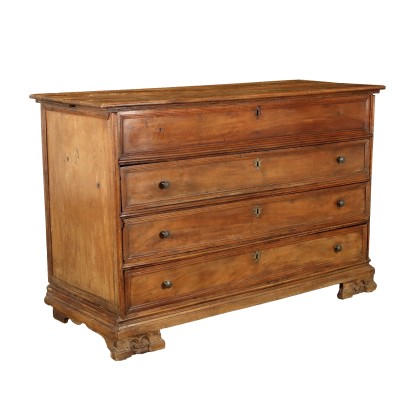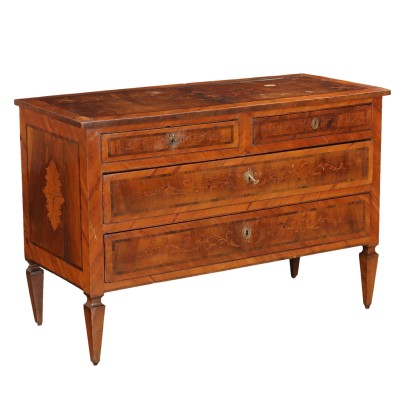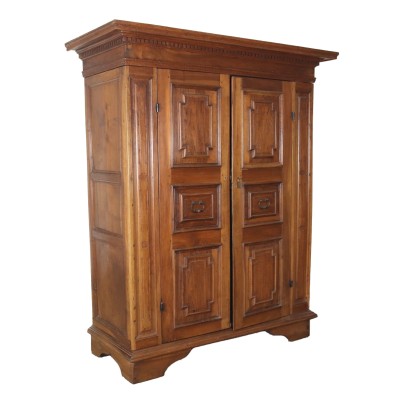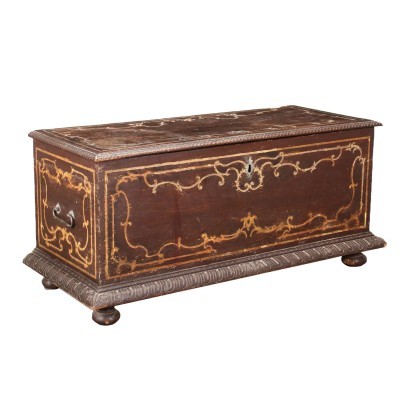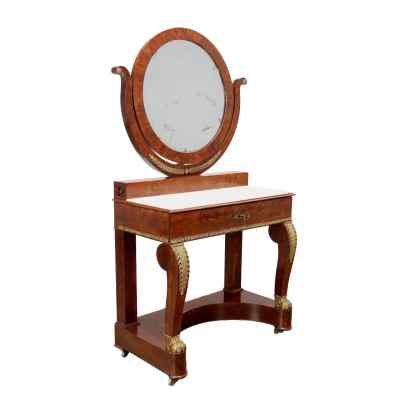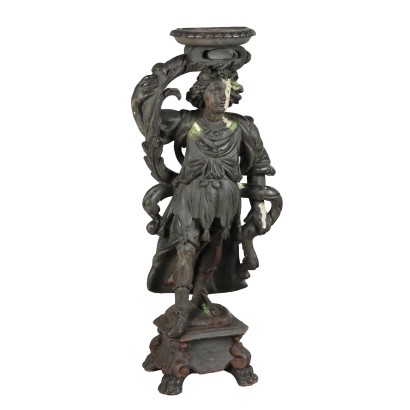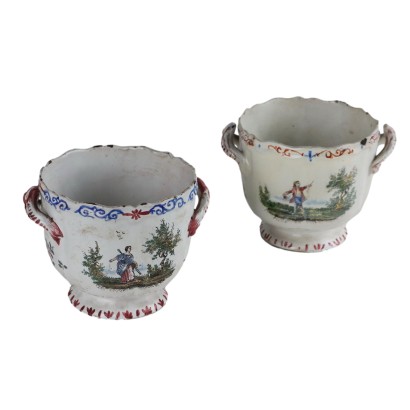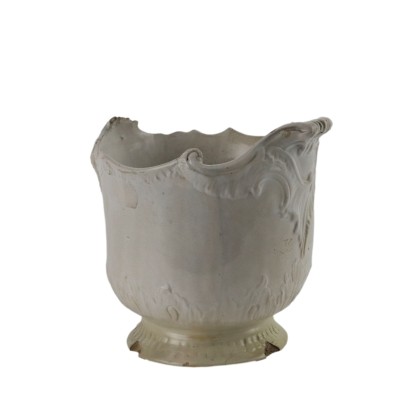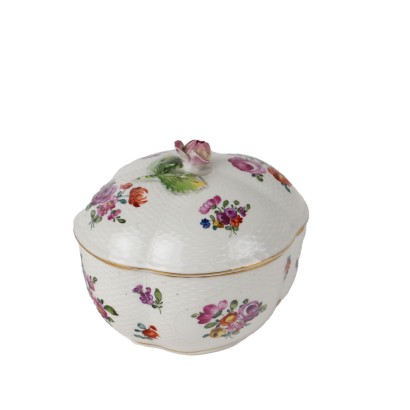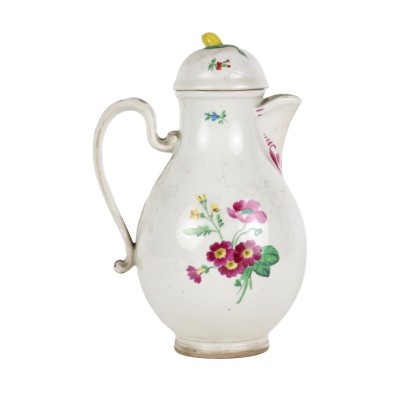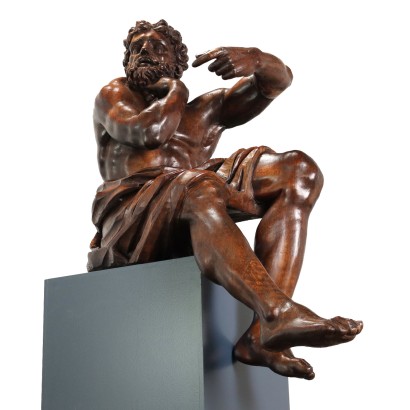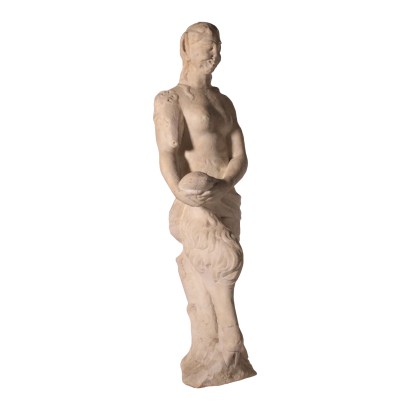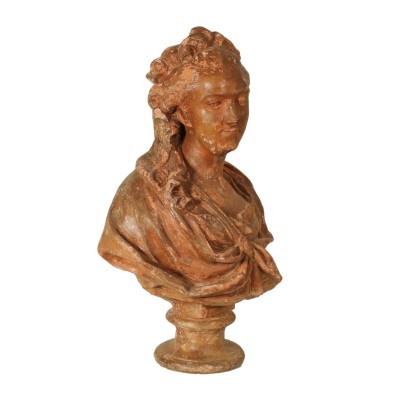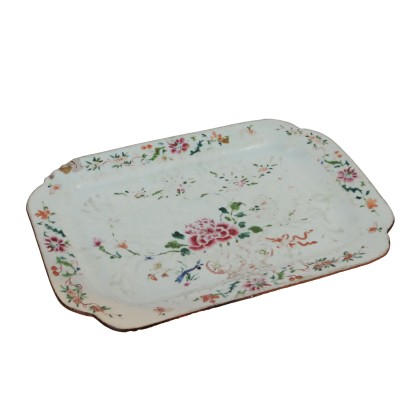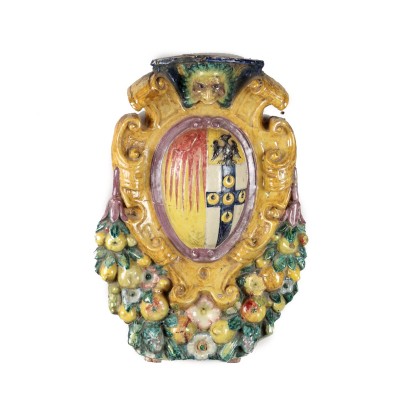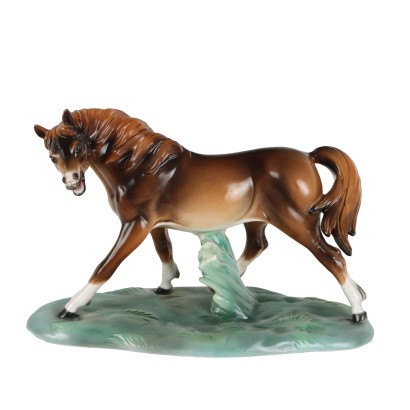Chest of Drawers Baroque Pear Wood Italy XVIII Century - Italy, Early XVIII Century
Features
Italy, Early XVIII Century
Style: Baroque (1630-1730)
Age: 18th Century / 1701 - 1800 , 17th Century / 1601 - 1700
Origin: Lombardia, Italy
Main essence: Pear Wood
Material: Bronze
Description
Lombard Baroque chest of drawers in pear wood, Italy, early 18th century. Front with 4 drawers decorated with frames and tiles, the first one equipped with a calatoia; bronze knobs, paneled sides, bracket feet. Originally entirely ebonized and subsequently stripped and brought to wood. A small drawer is missed.
Product Condition:
Product that due to age and wear requires restoration and re-polishing. We try to present the real state of the furniture as fully as possible with photos. If some details are not clear from the photos, what is reported in the description will prevail.
Dimensions (cm):
Height: 115
Width: 145,5
Depth: 59
Additional Information
Style: Baroque (1630-1730)
The term derives from the Spanish phoneme barrueco or portuguese barroco and literally means "shapeless pearl".Already around the middle of the eighteenth century in France it was synonymous with unequal, irregular, bizarre, while in Italy the diction was of medieval memory and indicated a figure of the syllogism, an abstraction of thought.
This historical period was identified with the derogatory term of baroque, recognizing in it extravagance and contrast with the criteria of harmony and expressive rigor to which it was intended to return under the influence of Greco-Roman art and the Italian Renaissance.
Baroque, secentista and secentismo were synonymous with bad taste.
As far as furniture is concerned, ideational freedom, the need for pomp and virtuosity originated a synergy destined to produce unsurpassed masterpieces.
The materials deployed were worthy of competing with the most astonishing tales of Marco Polo: lapis lazuli, malachite, amber, ivory, tortoiseshell, gold, silver, steel, precious wood essences and more, dressed the furnishings that by shape and imagination virtually gave life to the a thousand and one nights of many powerful Italians.
Typical of the period were load-bearing or accessory parts resolved with spiral column motifs, clearly inspired by the Berninian canopy of St. Peter, parts with rich sculptural high-relief carving and even in the round within a whirlwind of volutes, cartocci and spirals, curved and broken profiles , copings shaken by gables of articulated shaping, aprons adorned with ornaments, corbels, buttresses and anything else needed to move shapes and structures.
The Baroque is, moreover, the century of illusionism: lacquers and thin tempera flock to furniture and furnishings to imitate with the marbling effects of marble veins or games of precious briars.
Find out more about the Baroque with our insights:
FineArt: Il Barocco
Classic Monday: a double sideboard body, late Venetian Baroque
Classic Monday: a pair of candle holders between Renaissance and Baroque
Classic Monday: a pair of mirrors between Baroque and Barocchetto
Classic Monday: a superb Austrian Baroque console
YouTube - A few bits of furniture history ep1: the Baroque
Age:
18th Century / 1701 - 1800
18th Century / 1701 - 180017th Century / 1601 - 1700
17th Century / 1601 - 1700Main essence: Pear Wood
Hard wood, with a smooth pinkish grain. Used mainly for the construction of country furniture and secondarily for carvings. It was often dyed glossy black to mimic and replace ebony in veneersMaterial: Bronze
Other customers have searched:
Cassettiera, cassettone, settimanale, mobile da camera, commode, canterano, comò..
Approfondimenti
Scopri di più su cassettiere e comò grazie ai nostri approfondimenti:
La storia nascosta in due antichi cassettoni
Conoscere il Neoclassicismo attraverso un cassettone piacentino
Un comò piemontese influenzato dal fascino per l'Oriente
Un signorile comò rococò napoletano
Una caratteristica cassettiera con alzata emiliana di perfetto gusto barocchetto
E per gli appassionati dal gusto più raffinato, c'è FineArt:
Commode a tre cassetti G.B.M., inizio XIX secolo
Canterano dipinto
Canterano emiliano, primo quarto XVIII
Cassettone a ribalta romano, secondo quarto XVIII secolo
Comò attribuito a Luigi Viglione, Luigi XVI, fine XVIII, Torino
Coppia di comò e comodino di Maggiolini
Sull'antiquariato in generale dai un'occhiata anche a
Classic Monday: da un pezzo dei nostri magazzini alla storia dell'antiquariato
L'antiquariato dalla A alla Z: il Dizionario dell'Antiquariato
Il dizionario dell'antiquariato - Lastronatura
Il dizionario dell'antiquariato - Mascherone
Il dizionario dell'antiquariato - Natura morta
Il dizionario dell'antiquariato - Opificio
Il dizionario dell'antiquariato - Pastiglia
Il dizionario dell'antiquariato - Savonarola
Il dizionario dell'antiquariato - Rosone
Approfondimenti
Scopri di più su cassettiere e comò grazie ai nostri approfondimenti:La storia nascosta in due antichi cassettoni
Conoscere il Neoclassicismo attraverso un cassettone piacentino
Un comò piemontese influenzato dal fascino per l'Oriente
Un signorile comò rococò napoletano
Una caratteristica cassettiera con alzata emiliana di perfetto gusto barocchetto
E per gli appassionati dal gusto più raffinato, c'è FineArt:
Commode a tre cassetti G.B.M., inizio XIX secolo
Canterano dipinto
Canterano emiliano, primo quarto XVIII
Cassettone a ribalta romano, secondo quarto XVIII secolo
Comò attribuito a Luigi Viglione, Luigi XVI, fine XVIII, Torino
Coppia di comò e comodino di Maggiolini
Sull'antiquariato in generale dai un'occhiata anche a
Classic Monday: da un pezzo dei nostri magazzini alla storia dell'antiquariato
L'antiquariato dalla A alla Z: il Dizionario dell'Antiquariato
Il dizionario dell'antiquariato - Lastronatura
Il dizionario dell'antiquariato - Mascherone
Il dizionario dell'antiquariato - Natura morta
Il dizionario dell'antiquariato - Opificio
Il dizionario dell'antiquariato - Pastiglia
Il dizionario dell'antiquariato - Savonarola
Il dizionario dell'antiquariato - Rosone




